Possible Complications and Side Effects of Having an Abortion
🛤 Could an abortion affect me long term? — Take the Test
-
From a medical standpoint, abortion is generally not considered a major operation. Nevertheless, it disrupts biological processes within a woman’s body.
-
Depending on the abortion method, risk factors and side effects may include heavy bleeding and infection.
-
Consult a doctor whom you trust before considering an abortion. Take time to examine your unique situation, weighing any concerns you might have.
-
Abortion from a Medical Standpoint
Risks and Side Effects of a Medical Abortion (Abortion Pill)
Risks of an Abortion by Vacuum Aspiration
Risks and Side Effects of a D&C
Risks and Side Effects of a D&E
Risks and Side Effects of an Induction Abortion
Information and Support in Your Decision-Making Process
Could an abortion affect me long term? — Your Self-Evaluation
Do you find yourself in this situation? Answer three multiple-choice questions about your circumstances, and receive an expert evaluation within seconds on your screen.
Abortion from a Medical Standpoint
Abortion is considered a comparatively minor procedure from a medical standpoint (e.g. compared to major abdominal surgery). Nevertheless, the termination of a pregnancy is an abrupt interruption of biological processes within the woman’s body — processes that have been taking place since the very first moment of conception.
Do Abortions Hurt?
As you consider your options, you may wonder whether abortions are painful. Physical side effects of abortion differ from woman to woman and can, therefore, not be predicted precisely.
Still, three factors play a role in anticipating the level of pain involved in an abortion:
- Her general health and fitness
- The abortion method — namely, whether the abortion was performed using the abortion pill, vacuum aspiration, dilatation and curettage (D&C), dilatation and extraction (D&E), or late-term induction
- The type of anaesthesia — i.e., sedation or local anesthaesia
Discussing individual risks with the attending physician is essential regardless of the method.
- Read about the possible emotional repercussions of abortion.
Medical Abortion (Abortion Pill)
A medical abortion (aka chemical abortion) is performed using the drug mifepristone in combination with a prostaglandin (a labour-inducing drug).
- For more information on the procedure, go to Abortion via Abortion Pill.
Initially, an abortion using medication may seem gentler and less stressful to the woman’s body — rather than undergoing surgery. However, medical abortions via the 'abortion pill' can be physically challenging and carry certain risks:
Risks and Side Effects
- Medical abortions trigger bleeding, often heavier than a regular menstrual period.
- Cramping is a common accompanying symptom, which many women experience as more painful than typical period pain.
- Abortions via medication take longer than the surgical procedure. Vaginal bleeding may continue for up to 12 days.
- Headaches, nausea and dizziness are also common, since prostaglandins often adversely affect one’s circulatory system.
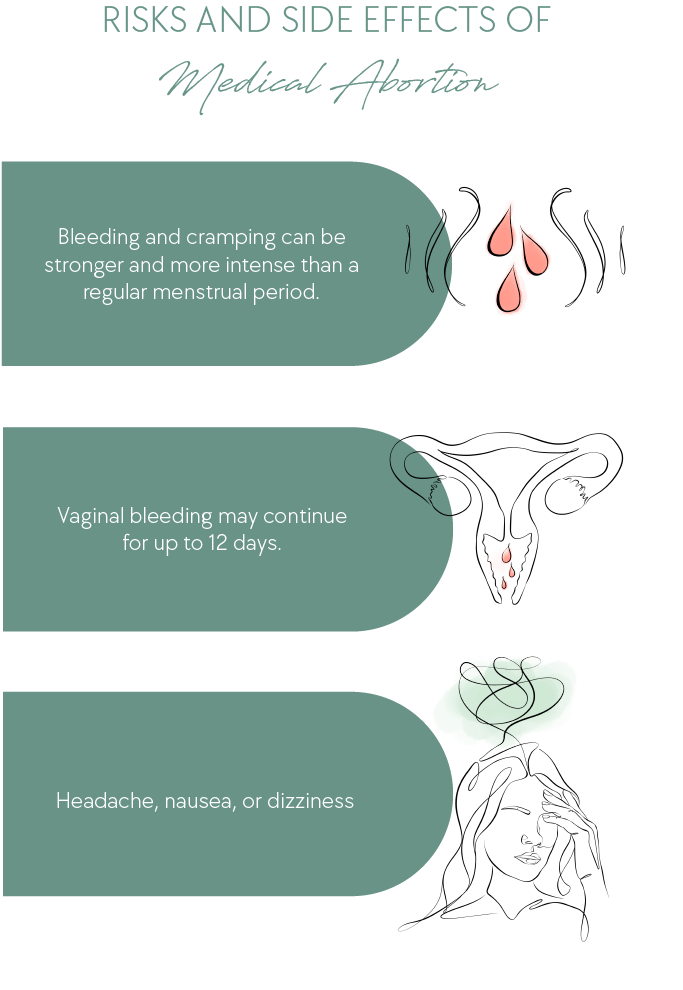
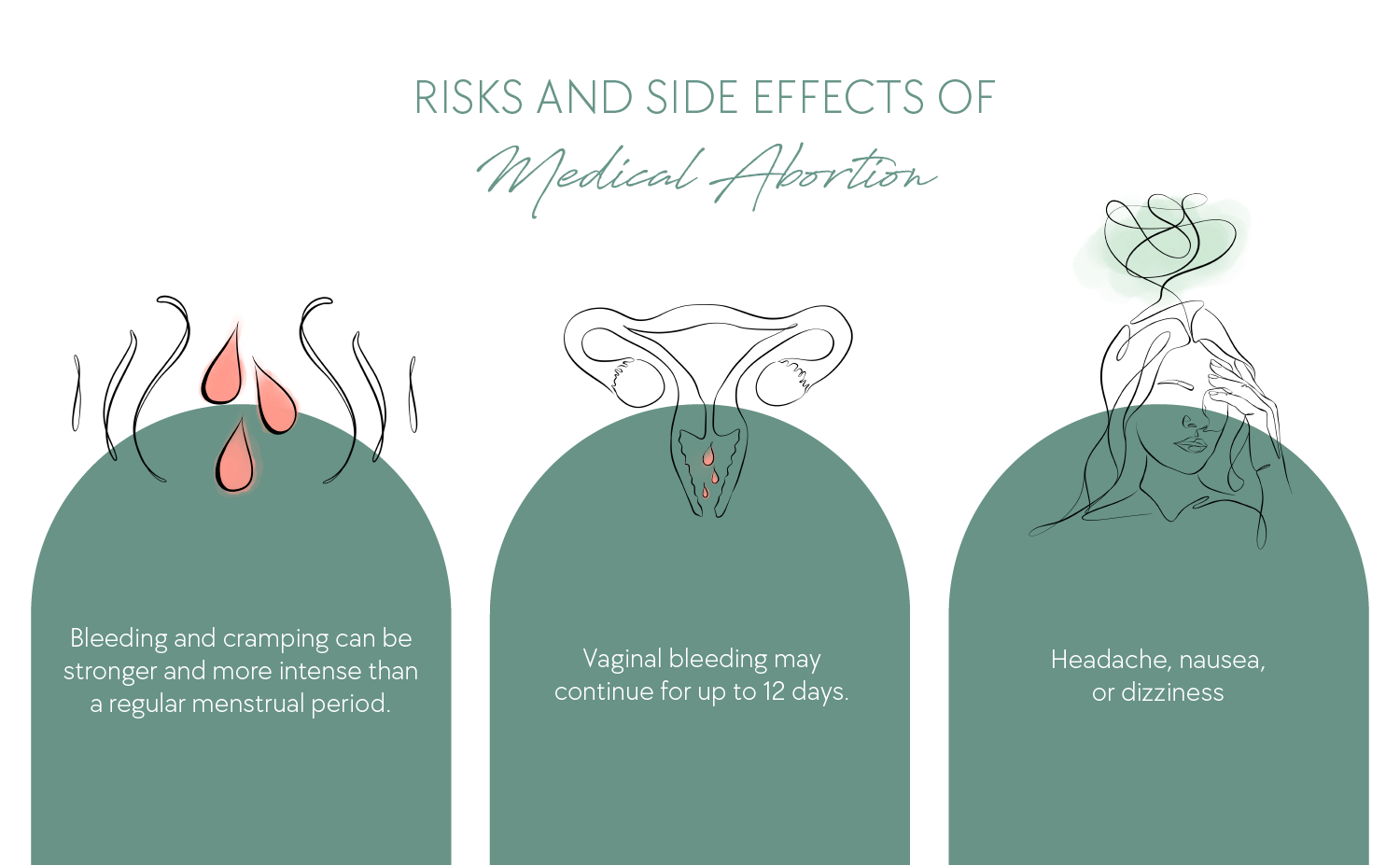
Possible Repercussions
- Medical abortions cause a hormonal imbalance. While the body tries to regulate its hormone levels again, irregular periods can be expected.
- Tissue remnants may remain in the uterus after a medical abortion. This may necessitate a D&C, which is usually performed under sedation.
ℹ️ Medical abortions should be performed under medical doctor's supervision to ensure serious complications are avoided.
Abortion by Vacuum Aspiration
Vacuum aspiration accounts for almost 50% of first-trimester abortions worldwide. Go to Abortion via Vacuum Aspiration to read more information about this abortion method.
The number of complications using vacuum aspiration is lower than with D&Cs. Nevertheless, there are also adverse effects and possible risks involved in having a vacuum aspiration abortion:
Risks and Side Effects
- Pain: the uterus reacts to the suctioning by initiating contractions, similar to labour pain, to contract back to its original size. This may lead to intense cramping, which can be compared to the pain at the onset of a heavy menstrual period.
- Postpartum bleeding can last up to two weeks and is usually lighter than a regular menstrual period. Heavy bleeding is unusual, but possible. Some women do not start bleeding until three to five days after the procedure, followed by several days of spotting.
- Increased risk of infection during post-abortion bleeding: the risk of a uterine infection accompanies any abortion. It is advisable to avoid tampons, sexual intercourse, taking baths, swimming, as well as sauna visits. Inflammation of the abdominal wall or fallopian tubes may also result from the abortion procedure.
- Very rarely, haemorrhaging occurs when medical instruments accidentally perforate the delicate uterine wall. Such injuries require emergency care, and can necessitate the complete removal of the uterus (hysterectomy).
Risks and Side Effects of Vacuum Abortion — Overview

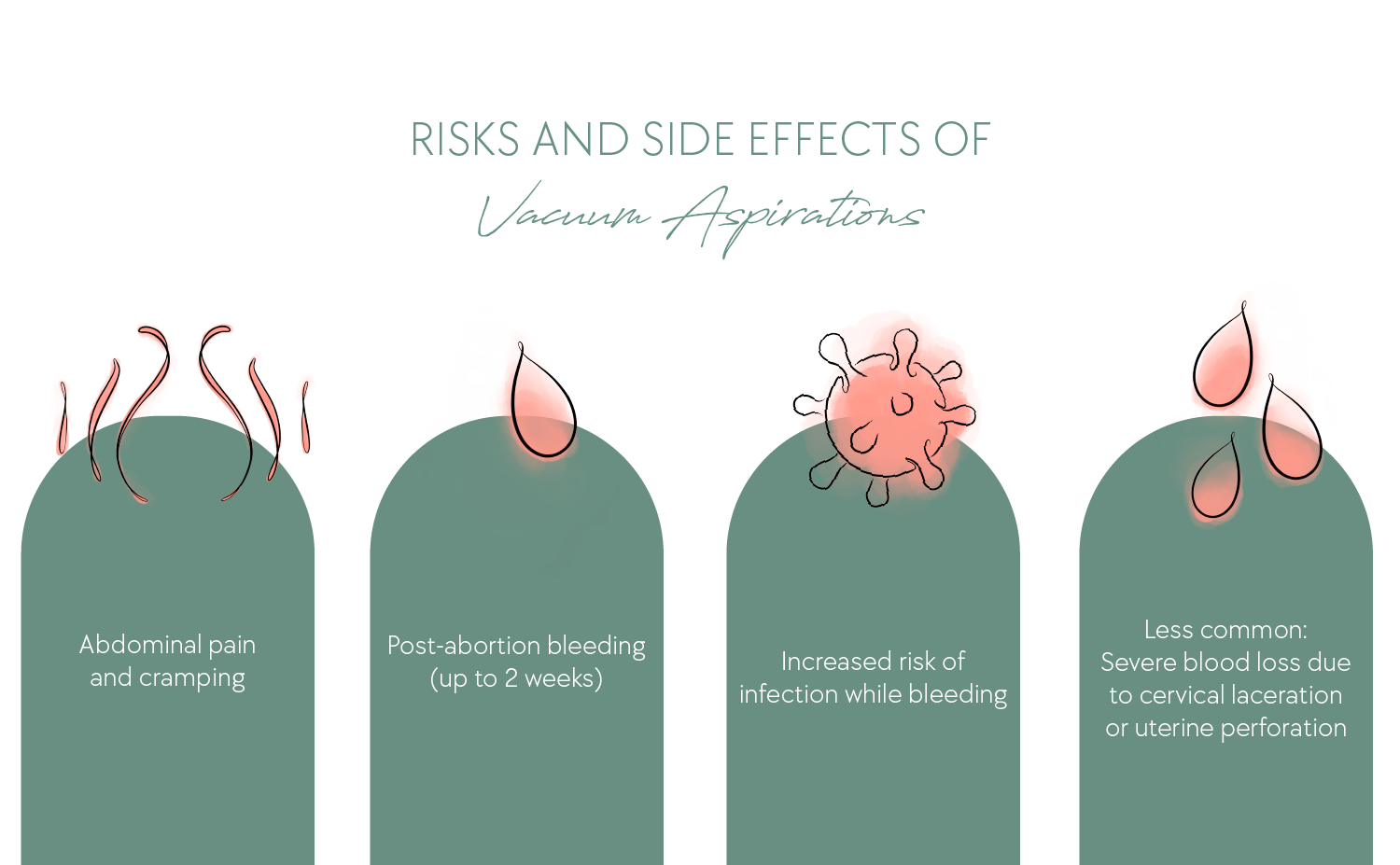
Possible Long-Term Effects
The risk of premature birth in subsequent pregnancies (cervical insufficiency) may increase, if the mucosa, uterus or cervix has been weakened by an injury incurred by the abortion instruments.
D&C (Dilatation & Curettage)
D&Cs are less common because of the higher rate of complications. However, they are usually necessary when vacuum aspiration has failed to remove all tissue remnants. For more information on dilatation and curettage abortions, go to D&C Abortion (Dilation and Curettage).
In addition to the risks accompanying vacuum extractions, the following risks must be considered before having a D&C:
- An injury to the uterine wall can cause scar tissue to develop (Asherman syndrome), increasing the risk of future miscarriages.
In rare cases, abortion by D&C may lead to severe complications, which can result in infertility. This can happen if the uterine wall was thinned to such an extent that the implantation of a fertilised egg is no longer possible.
Barring all complications and long-term side effects, abortions usually leave no physical trace.
ℹ️ Surgical abortion methods (vacuum aspiration, D&C and D&E) are commonly performed under general or local anaesthesia. Any choice of anaesthesia is accompanied by risks and side effects. For more information, go to Abortion — Which Type of Anaesthesia?
Risks and Side Effects of Late-Term Abortions
Apart from the increased likelihood of emotional strain, late-term abortions also have physical repercussions. Late-term abortions are most commonly performed by D&E or induction.
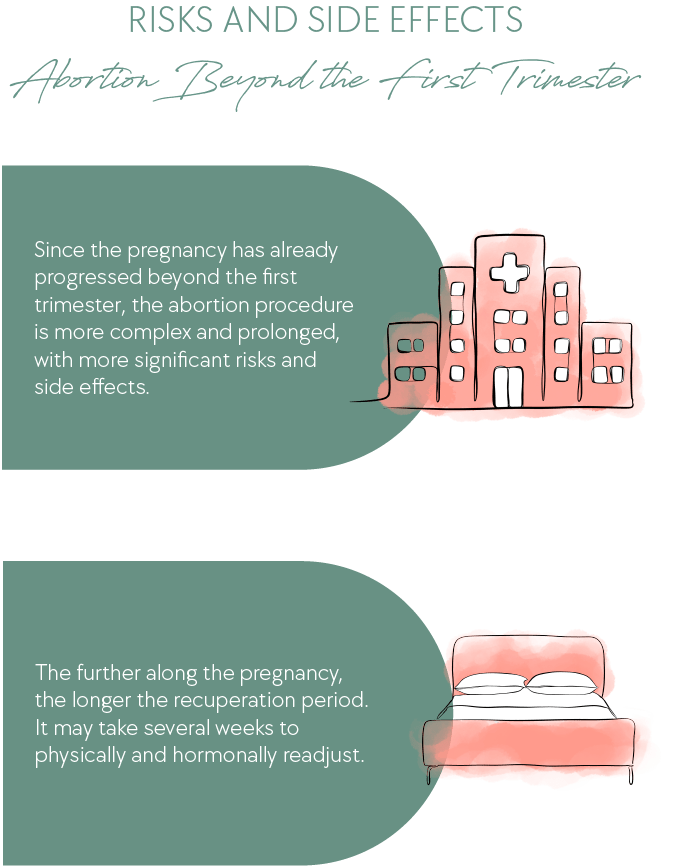
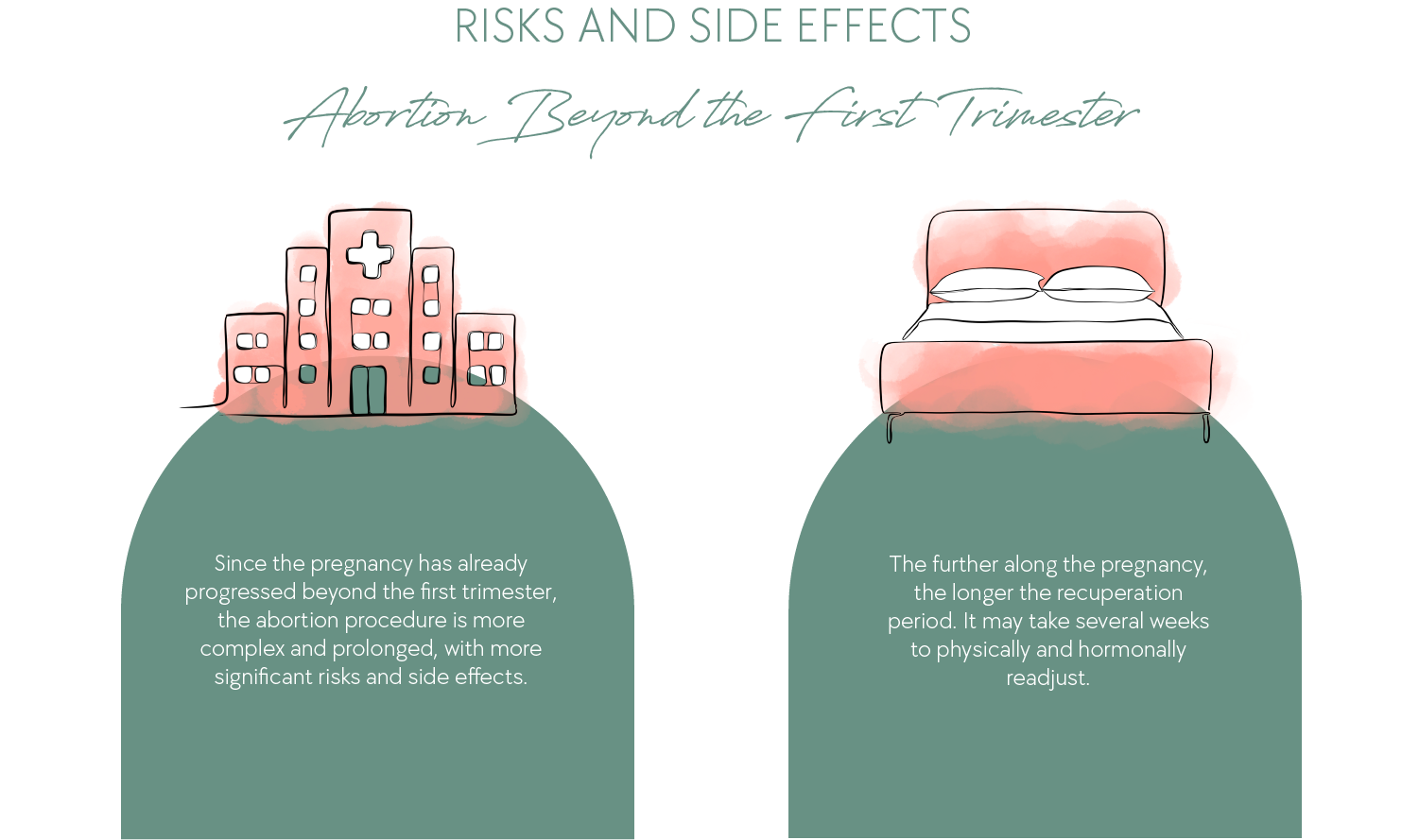
D&E (Dilatation & Evacuation)
D&E is the most common late-abortion method in the United Kingdom and many other countries, as it does not require an overnight hospital stay. For more information on D&E abortions, go to D&E Abortion (Dilatation and Evacuation).
The further along you are in the pregnancy, the greater the risk of complications. 3.8% of women encounter the following complications after a D&E:
- Cervical laceration
- Retaining foetal tissue
- Infection
- Uterine perforation
- Extramural delivery (delivery of foetus due to dilation before the surgery)
- Haemorrhage
Induction Abortion
Induction abortions involve taking medication to induce labour. The process may take 24 to 72 hours, requiring a hospital stay. For more information on abortions by induction, go to Induction Abortion.
- Abortion via Induction means undergoing the physical strain of a complete birth, including contractions and the risk of birth complications.
- Occasionally, induction abortions require surgery after the delivery because of a retained placenta.
- During the postpartum period, several weeks of bed rest may be necessary for the body to readjust hormonally to a non-pregnant state. In addition, breast milk may come in, requiring lactation-suppressing medication.
For more information, go to:
Information and Support in Your Decision-Making Process
While this article hopefully provided you with the information you were looking for, your search likely goes much deeper. So many unanswered questions are probably running through your mind: Why me? What now?
You are not alone! Our team of caring experts has compiled judgement-free resources to aid you in discerning the path that is right for you.
- ⚖️ Should I have an abortion? — Take the Abortion Test
- 🏥 Abortion methods — What do I need to know?
- ⛑ Where do I go from here? — Quick Answers Quiz
An immediate evaluation follows each test.
Our Top Picks for You




















